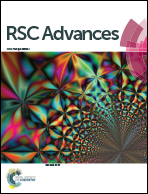Influence of low Bi contents on phase transformation properties of VO2 studied in a VO2:Bi thin film library†
Abstract
A thin-film materials library in the system V–Bi–O was fabricated by reactive co-sputtering. The composition of Bi relative to V was determined by Rutherford backscattering spectroscopy, ranging from 0.06 to 0.84 at% along the library. The VO2 phase M1 was detected by X-ray diffraction over the whole library, however a second phase was observed in the microstructure of films with Bi contents > 0.29 at%. The second phase was determined by electron diffraction to be BiVO4, which suggests that the solubility limit of Bi in VO2 is only ∼0.29 at%. For Bi contents from 0.08 to 0.29 at%, the phase transformation temperatures of VO2:Bi increase from 74.7 to 76.4 °C by 8 K per at% Bi. With X-ray photoemission spectroscopy, the oxidation state of Bi was determined to be 3+. The V5+/V4+ ratio increases with increasing Bi content from 0.10 to 0.84 at%. The similarly increasing tendency of the V5+/V4+ ratio and Tc with Bi content suggests that although the ionic radius of Bi3+ is much larger than that of V4+, the charge doping effect and the resulting V5+ are more prominent in regulating the phase transformation behavior of Bi-doped VO2.



 Please wait while we load your content...
Please wait while we load your content...